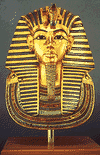Ward's Book of Days.
Pages of interesting anniversaries.
What happened on this day in history.
FEBRUARY 16th
On this day in history in 1923, Howard Carter unsealed the burial chamber of the Pharaoh Tutankhamen.
The discovery of the intact tomb of Tutankhamen was
the foremost contribution to the study of Egyptology.
Howard Carter had received little or no education. He had been born in
Brompton, London, in 1874, brought up in Swaffham, Norfolk, and given some training in drawing and painting. At the age of 17, he
obtained a post with the British Archaeological Survey of Egypt, copying
hieroglyphs and drawings.
Carter
worked for eight years with the British Survey, copying out inscriptions and
hieroglyphs for translation by the erudite members of the group, and would
have liked to have carried out his own excavations but promotion was denied to
him on account of his lack of education. In 1899, Carter obtained a job with
the Egyptian government’s Antiquities Department, supervising excavations in
the Valley of the Kings, the most prolific excavation site in Egypt. He discovered the tombs of Hatshepsut and Thutmose IV, and his research
indicated the existence of a previously unknown pharaoh, Tutankhamen.
Unfortunately, Carter was obliged to resign after an altercation
between the site guards and a group of bellicose French tourists.
In
1907, Carter was sought out by Lord Carnarvon, a distinguished collector, who
promised funds for a private search for the elusive Tutankhamen. Carter
searched for years for the lost pharaoh but without results, and Carnarvon was
on the point of discontinuing the operation, when, in 1922, Carter found the
entrance to a tomb. He telegraphed Carnarvon to come at once, hoping that this
was indeed the resting place of Tutankhamen and not daring to enter without
his patron being present.
When Carnarvon and his entourage eventually arrived, Carter made a breach in the
doorway and, with the aid of a candle, saw a hoard of gold and ebony effects
and two sentinel statues, guarding the entrance of what seemed to be a burial
chamber.
Carter
had to obtain permission from the Egyptian authorities before opening the
burial chamber. Meanwhile he catalogued the contents of the antechamber. On 16th
February 1923, Carter and Carnarvon, accompanied by Egyptian state officials,
opened the sealed doorway and found the sarcophagus of Tutankhamen. It has
been suggested, from sources in Carter’s notes, that Carter and his patron
had taken a sneak preview of the burial chamber, feeling that their investment
of effort and money entitled them to take the honour of the first peek at the
tomb.
Carter catalogued and recorded the entire collection but, when he unwrapped the linen bandages of the mummy, the pharaoh’s skull fell away from the body and landed on the stone pavement, making a slight indent. Apart from this minor calamity, Carter ensured that the collection reached the safety of the National Egyptian Museum
Carter then retired from active archaeology and became a showman of Egyptology, touring the United States, giving illustrated lectures on his discoveries to large and attentive audiences. Carter died at the age of 64, giving the lie to the alleged ‘Curse of the mummy’s tomb’, and is buried in Putney Vale Cemetery. [Putney Vale Cemetery, Stag Lane, London, SW15 3DZ]

©2006 Ward’s Book of Days